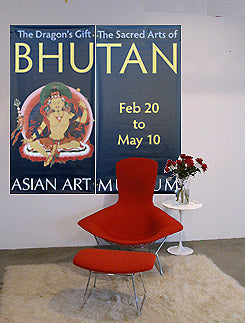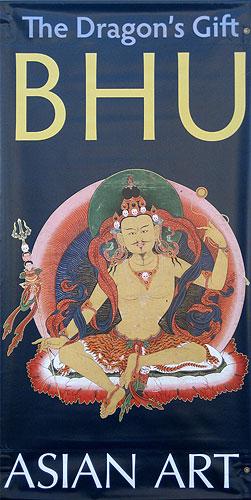Asian Art Museum
Bhutanese "Buddhist Thangka"
Bhutanese "Buddhist Thangka"
Couldn't load pickup availability
Share
Limited Edition: 35
Exhibition: The Dragon’s Gift: The Sacred Arts of Bhutan
Material: Printed vinyl
Dimensions: 35" x 72" (88cm x 182cm)
Hanging Hardware Included
These banners are offered for sale as a pair. The complete image spans two banners which, hung side-by-side, create an amazing diptych which covers a 6’ by 6’ space. Just place one (1) banner in your shopping cart, and you will receive two so you may display the banners as originally designed.
Summary
First created in Tibet, thangka art was also popular in the remote mountain kingdom of Bhutan. Painted on fabric or paper with paints, inks, or dyes, thangka served as colorful icons for Buddhist worship. Considered spiritual objects, the pieces are also gorgeous works of art. Many Bhutanese artworks were brought together in the exhibition The Dragon's Gift: Sacred Arts of Bhutan at the Asian Art Museum.
Description
There are two constants in Bhutanese art: it is religious and it is anonymous. Artists follow strict conventions about how stories are told and, in almost all cases, the subject of Bhutanese art is the life and teachings of Buddha and the cycle of his reincarnation. The art often takes the form of the thangka, a style taken from Tibet. Painted with pigments and dyes on paper or fabric, thangka follow highly symbolic storylines in a highly geometric style.
This banner features a thangka of a seated Guru Nyima Ozer, the Sunray Yogi. He is believed by some Buddhists to be a reincarnation of Buddha, and is on manifestation of “The Lotus Born”, an Indian sage said to have brought Tantric Buddhism to Bhutan and Tibet in the 8th century. In this image by an early 19th- century Bhutanese artist, the Guru is shown naked save for a tiger skin loincloth. His Khatvanga (staff adorned with skulls and streamers) points up toward the sun, as he represents the illumination of the darkness of the mind through the insight of Dzogchen (the natural, primordial state of the mind that leads to enlightenment). Painted with rich colors and great detail, the artist shows both the fine detail of the Guru’s face and body, and the swirling motion all around him. The work, as other Bhutanese art, is not considered art by Buddhist worshippers. It is an object for ritual use; a sacred image that aids in Buddhist practices. The Bhutanese Ambassador to the UN explained that the show was not an exhibition, but rather “a special opportunity for those who visit to receive blessings from these special objects.”
These banners were designed to be hung side-by-side on a street pole, so hanging two together creates a complete diptych. On the front, the image floats on a dark blue background. Above white and yellow text reads “The Dragon’s Gift/BHU”, and below the image white letters read “Asian Art”. The message is completed on the back of the banner which is also dark blue. Above the image white and yellow text reads “Sacred Arts of/TAN”, and below in white “Museum/Feb 10 – May 20”.
Provenance
These banners were displayed around San Francisco from February 20 through May 10, 2009 to promote the exhibition The Dragon’s Gift: The Sacred Arts of Bhutan at the Asian Art Museum. The exhibition was also seen at the Honolulu Academy of Arts, The Rubin Museum of Art in New York, the Musée Guimet in Paris, and the Museum of East Asian Art in Cologne.












